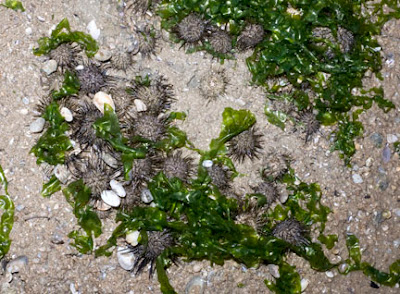There were a few other new sightings too, and we also met some familiar favourites.
The reason why we've called it this? Because it waggles its white butt! Pei Yan took this great video clip of the shrimp 'dancing'. Check out her blog for more stories and sightings.
There were some sea fans (Order Gorgonacea) growing on hard surfaces on the shore. I came across several different kinds of ovulids on these sea fans! Some animals live only on sea fans, like the Ovulid snail that's at the base of the sea fan in this photo.
I came across several different kinds of Ovulid snails (Family Ovulidae) that I've not seen for a long time! Some of them I've only seen at Beting Bronok.
Sadly, there is a lot of abandoned fishing lines entangled on hard surfaces on this shore. Some of the lines entangle sea fans, dragging them up to the high shore, or strangling them.
Here's a strange sea anemone that I've not seen before.
Here's a closer look at the sea anemone. It has a 'coat' of sand grains that is firmly stuck onto its short body column and doesn't 'slide off' as usually happens with other burrowing anemones. The short tentacles has speckles.
This part of Changi is very 'nemy' with all kinds of special anemones that are not so commonly seen elsewhere. Like this one that resembles a strawberry when its tentacles are tucked into its body which has red 'pimples'. The Tiger anemone has yet to be identified.
I came across this sea cucumber that so far I've only seen on this Changi shore. It has yet to identified. There were many Thorny sea cucumbers (Colochirus quadrangularis) and Warty pink sea cucumbers (Cercodemas anceps) and Ball sea cucumbers (Phyllophorus sp.).
Another colourful creature often seen on this shore is the psychedelic and toxic Sea apple sea cucumber (Pseudocolochirus violaceus). In the past, we used to see several of these animals.
There are a lot more Cerianthids (Order Ceriantharia) aka Peacock anemones on this shore than other parts of Changi. They are not true sea anemones! Among the many cerianthids is this intriguing dark one. We still haven't sorted out the identities of our cerianthids yet.
I came across several Ball flowery soft coral (Family Nephtheidae). One of them had a white snapping shrimp that only lives in these soft corals. I also saw many Slender sea pens (Virgularia sp.), a few flowery sea pens (Family Veretillidae) and Spiky sea pens (Pteroides sp.).
Often, all kinds of animals are found near cerianthids. Like this pair of Elbow crabs (Family Parthenopidae) that look like they are mating. I often see various small crabs mating or about to mate near cerianthids. I have no idea why.
Miliaris cowries (Cypraea miliaris) are often found in pairs. I also saw several Calf moon snails (Natica vitellus) and some Fan clams (Family Pinnidae). We didn't see many nudibranchs today.
Large numbers of small Black sea urchins (Temnopleurus sp.) were huddled together in a small part of the shore.
I only saw one large White sea urchin (Salmacis sp.), and another smaller one with brighter pink square-tipped spines. The shells around the smaller sea urchin were probably dropped by the sea urchin which was carrying them.
I saw several small Cake sea stars (Anthenea aspera), many Biscuit stars (Goniodiscaster scaber) of various sizes and a few sand stars (Astropecten sp.). Pei Yan saw a Luidia sea star (Luidia sp.). But we didn't see any other special sea stars. There were also many flat-armed brittle stars as well as other brittle stars.
I saw some seagrasses with long narrow leaf blades that might be the Hairy spoon seagrass (Halophila decipiens) (orange arrow). These were growing among ordinary oval leafed Spoon seagrass (Halophila ovalis).
Further along, I saw more Hairy spoon seagrass growing on large mats of Nest mussels (Musculista senhousia). I saw this on this shore in Jul 2012 as well as at another Changi shore.
There was also some Fern seagrass (Halophila spinulosa), all looking fresh and green.
Ooo, are these dugong feeding trails in the seagrass meadows? We saw more furrows on this Changi shore in May 2011. We also saw dugong feeding trails in the seagrass meadows across the narrow Changi Creek near the buildings with the red roofs in Jan 2013.
I saw many patches of this Beige sheet ascidian growing on seagrasses.
Just before heading home, we have a quick look at the rocky area just opposite the Changi Point Ferry Terminal where we take the bumboats to go to Pulau Ubin.
The rocks are thickly covered in Zebra corals (Oulastrea crispata) and various colourful sponges.
Passing boats create strong waves that pound the shores. In the photo below, thick and very soft mats of Nest mussels (Musculista senhousia) blanket large parts of the shore. We saw three people collecting on the shore.
Today, none of us saw an Estuarine seahorse (Hippocampus kuda), and I didn't see many fishes. I didn't see one but Chay Hoon saw a Seagrass octopus. Although still lively, the Changi shores we have visited recently seem to be changing.
The rest of the week, we head out Southerwards to check out some other reefier shores.
Posts by others on this trip
- Pei Yan with lots of photos and stories of Changi critters.

























